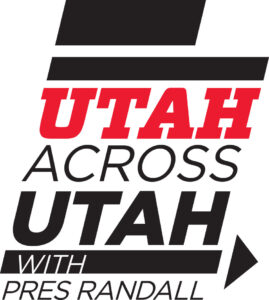 Like University of Utah presidents before him, Taylor Randall embarks on a north-to-south tour of the state this summer—starting with Ogden and Logan on June 23.
Like University of Utah presidents before him, Taylor Randall embarks on a north-to-south tour of the state this summer—starting with Ogden and Logan on June 23.
As the U president rounds out his first year leading Utah’s flagship institution of higher education, he plans to highlight the U’s partnerships and collaborations with other state colleges and universities in an effort to redefine and rededicate to the university’s unique role in Utah.
To guide and grow that statewide impact, Randall and the university’s Board of Trustees have signed a compact with the community—“Six Commitments” to Utah—including commitments to lead, educate, research, volunteer service, provide exceptional patient care and unify with sister higher education institutions. Read the Six Commitments here.
“As president of the University of Utah, I’m acutely aware of the responsibility we have—not only to educate and elevate our students—but also to improve the life of every Utahn,” Randall said. “To do that, we need to work together with higher education, business and community leaders throughout our state. This tour is a celebration of that collective effort and teamwork.”
The numbers tell the story of that statewide influence:
- Students come to the U from two-thirds of Northern Utah ZIP codes —including 2,016 students from Davis County, 606 from Weber County and 267 from Cache County
- U of U Health patients live in 96 percent of those ZIP codes—nearly 64,000 in Davis County, another 20,500 in Weber County and 5,600 in Cache County
- The U manages 550 buildings totaling 15.4 million square feet of space in 14 counties and 33 cities across Utah
- The U awards more than half of the advanced degrees awarded to Utah graduates
- The university is the state’s largest employer with 39,300 direct jobs, and directly and indirectly supports another 831,000 jobs
- The university trains 2/3 of Utah’s physicians
Although many Utahns might assume state colleges and universities are in competition with each other, Randall says they actually cooperate—developing new research; sharing service opportunities; and working collectively through the Utah System of Higher Education (USHE) to develop education policy and legislative initiatives.
Utah State University President Noelle E. Cockett agrees. “As Research 1 institutions, we bring in over $850 million of research grants and contracts each year to the Beehive State,” she says. “This research leads to discoveries that improve lives and create Utah jobs.”
Shared research projects between the U and Northern Utah colleges and universities include studies of air quality; climate change and drought; biodiversity and habitat protection; and rural education, among others.
Randall’s Utah road trip is focused on spotlighting those partnerships with the state’s colleges and universities; businesses and entrepreneurs; and local and state government leaders. On the first leg of the tour in Northern Utah, for example, the U president will meet with local elected leaders; executives at Northrup Grumman and ENVE Composites, and hold a working lunch to discuss areas of collaboration to save the Great Salt Lake.
Together, the U and Weber State maintain the Rocky Mountain Center for Occupational and Environmental Health, the first occupational health center established by state law in the country and one of 18 educational research center designated by the National Institute for Occupational Safety and Health (NIOSH). The center has enabled WSU to develop two new education programs—an interdisciplinary bachelor of science degree in occupational safety and health, and a graduate certificate in occupational health professions and nursing.
“In the days shortly following his appointment as president at the University of Utah, President Randall reached out to establish his willingness to partner and collaborate with Weber State to improve the way our institutions serve our students, communities, and state,” says Mortensen. “I appreciate his ongoing openness and collaborative efforts.”
The tour continues through the summer and into the early fall. Other regional legs of the tour include:
- Southern Utah, St. George
- Utah County
- Tooele County
- Eastern Utah—Moab, Price, Vernal
